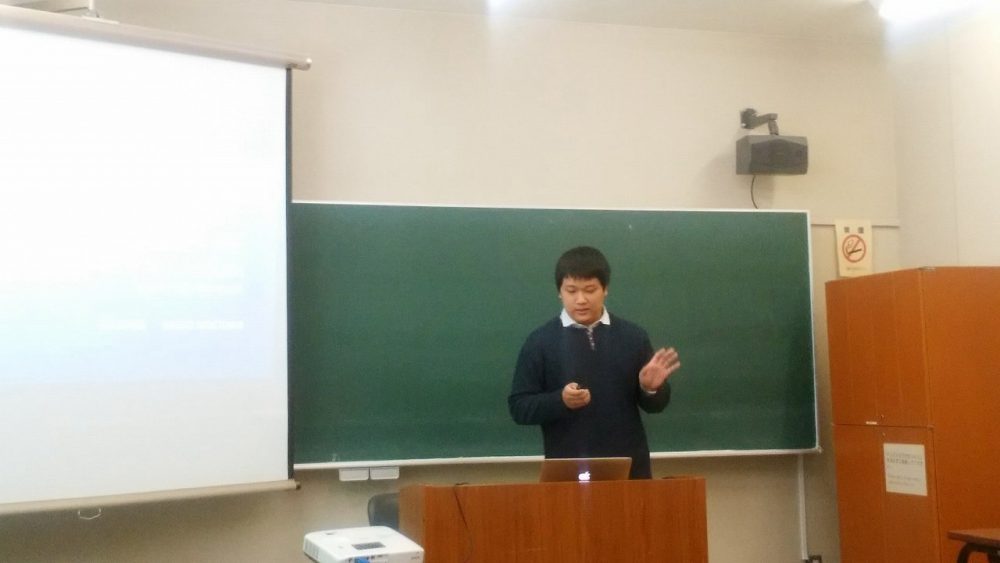
2016年度のエッセイ並びにプレゼンコンテストが開催されました。
結果とコメントは以下のとおりです。
エッセイコンテスト
First Place: Gen Matsuoka “Japan Should Ban election Campaign Cars”
Second Place: Rena Arisawa “Social Media Benefits Human Communication”
Commentary to Mr Matsuoka
Mr. Matsuoka’s essay is very well written on the topic of election campaign cars. Perhaps all of us have sometimes complained about various aspects of using campaign vehicles by politicians to solicit votes in an election. While some of these objections may seem obvious, Mr. Matsuoka has written a cogent essay, in which he strongly advocates that such vehicles should be prohibited during political campaigns. In the introduction, he succinctly explains the nature of the problem, and lays out his arguments that serve as a transition to the thesis statement, which is specific, concise and clear. These arguments are elaborated on in the body of the essay in great detail and explanation. The body of support information is well-organized, logical and clear with suitable transitions where needed. Mr. Matsuoka provides a relevant discussion of the current Japanese law that governs the use of campaign vehicles, and then expands on the reasons for his position in terms of the content of messages, the excessive noise that disturbs people, and the environmental impact on the community. His research and cited studies add compelling support to his position on this issue. At the end of his analysis, Mr. Matsuoka suggests viable alternatives to using cars in election campaigns. The conclusion sums up his arguments very well by effectively challenging the Japanese government to change the existing law.
Commentary to Ms Arisawa
Ms. Arisawa’s essay is written very well on the question of whether the use of social media is beneficial to human communication or harmful. While she recognizes that there are compelling arguments on both sides of this issue, Ms. Arisawa’s thesis statement clearly reflects her belief that the benefits far outweigh any negative criticisms. She systematically develops strong support information to show how social networking services positively impact communication from the standpoint of: facilitating connections with old acquaintances and friends; making users happier and more sociable; providing useful information during disasters; and encouraging users to participate in online discussions on a variety of topics and issues. Ms. Arisawa has researched this subject very well, and in most instances cites studies and surveys that convincingly support her assertions. The conclusion clearly summarizes her main points and encourages people to take advantage of the benefits that social media offer.
General Comments to All Participants
I wish to thank all the participants for their commitment and diligence in preparing essays that were interesting, well-organized and enjoyable to read. It was very difficult to choose the best essays from the wide variety of thought provoking essays submitted. Although only two contestants were awarded the top prizes, I believe everyone who participated in this competition gained from the experience. All of you were winners in the sense that you wrote very good essays in English on topics of real interest and relevance. To be selected as a contestant in this competition, it is readily apparent that you invested the extra time and effort to use your English writing skills to produce outstanding essays that separated your work from that of the many other students in all your classes. You have benefited for having done so. In the future, I hope you will continue to search for new opportunities that allow you enhance your writing and critical thinking skills. Just remember that writing is no different than learning many other skills. It requires practice, perseverance and patience. Take every opportunity to write and make the most of it. The more you write, the greater your chances for improvement in written accuracy, fluency, style and creativity.
- Appropriate Topic
- Persuasive Essay
- Format Includes:
- Introduction with thesis statement
- Each paragraph contains a topic sentence
- Body organized with strong arguments and sufficient supporting details
- Conclusion
- Grammar
- Quality of sentence construction
- Vocabulary used correctly for specific topics
- Transition between ideas
- Logical organization with a well-defined thematic focus
- Creativity
- Individual writing style
プレゼンコンテスト
First Place: Sakao Hidetoshi “The Use of Technology in English Teaching”
Second Place: Obara Kokoro “Talking to Strangers”
General Commentary:
The three mean criteria used to evaluate this year’s presentations were content, delivery, and language. Presenters who attained high grades in the content category were those who chose topics of adequate complexity, showed evidence of academic research to support their positions and conveyed their ideas in a structured, coherent and focussed manner. Design and format of visual aids were also important factors in evaluating content. Assessment of presentation delivery focussed on voice volume, fluency, use of hand gestures, body language, and eye contact. Finally, the criterion of language was judged based on the accuracy and range of grammar and vocabulary employed, as well as on the appropriateness of intonation and pronunciation. The ability of a presenter to respond precisely and confidently to questions posed after the presentation was also taken into account.
In general, the above presenters were selected as the winners because, in addition to meeting the above criteria, they appeared confident and well prepared. Preparation does not necessarily entail memorising a script, but rather thoroughly engaging with the topic, internalising one’s position, and offering a novel perspective. It is nevertheless also important to know the material well enough to be able to speak without long pauses or without over-reliance on a script. Successful speakers organised their speech so that important points and supporting ideas were presented in a coherent fashion, making it easy for their audience to follow. These presenters also used eye contact, body language and tone of voice to actively engage their listeners. As each presenter had their own combination of strengths and weaknesses, all would do well to consider the aspects of presentation planning and delivery described above and to focus on identifying and improving their own areas of weakness in the future.

